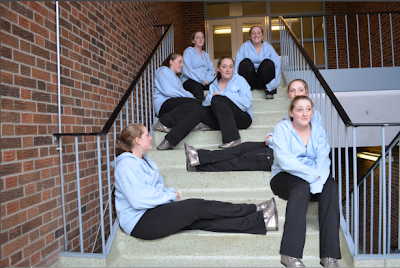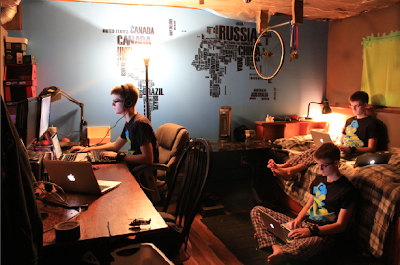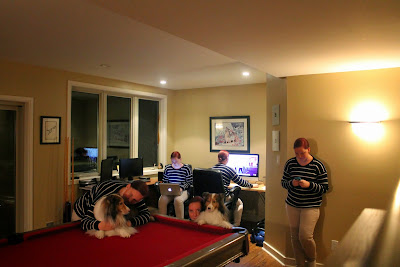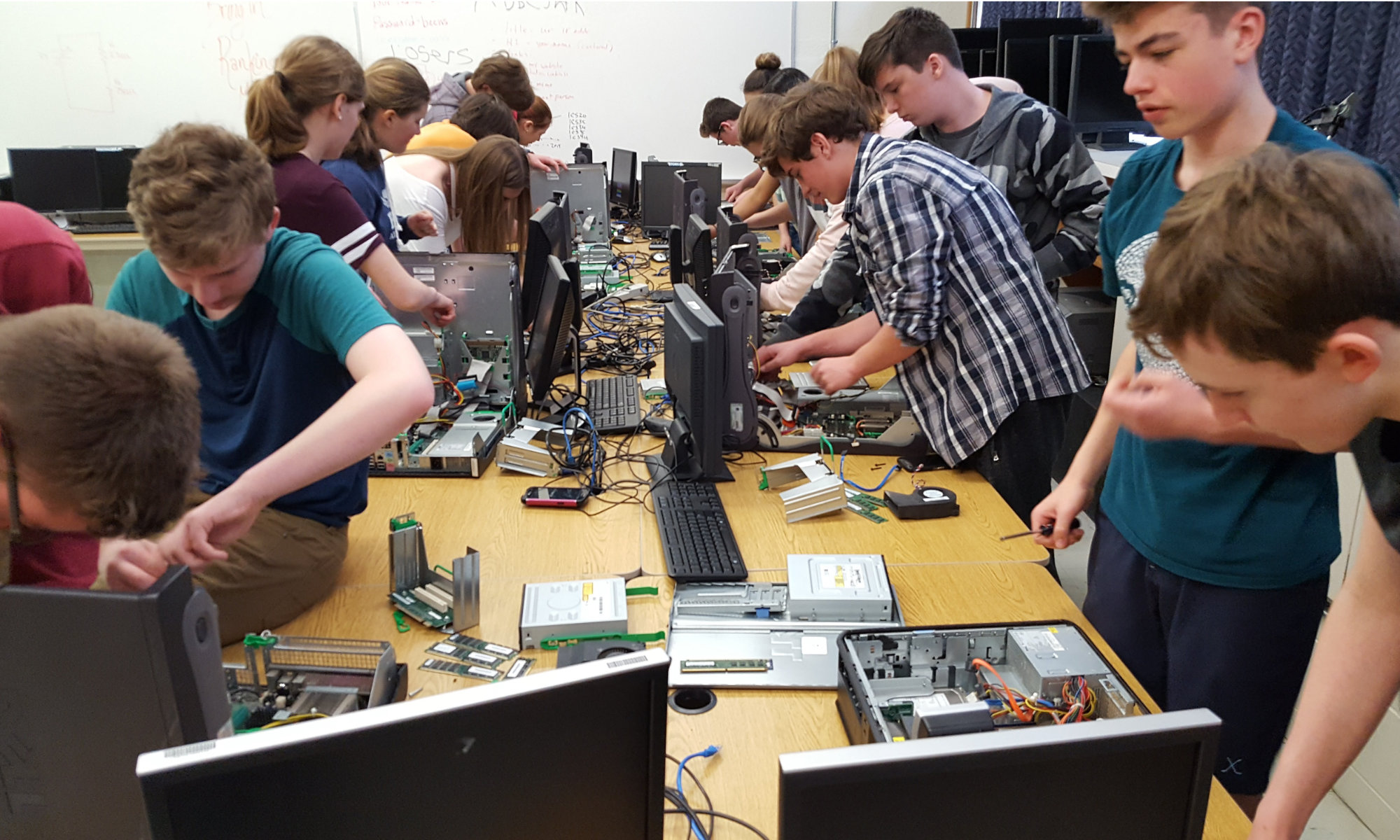ICT Ethics Assignment
Create an infographic (Affinity Designer is recommended for this) or Google Doc or podcast or video that shows an ICT-related ethical issue which:
- clearly defines what the issue is all about,
- convincingly shows us how to resolve it, and
- recommends alternatives/safeguards which exist to protect against such issues in the future (if applicable).
Topic Suggestions
- Music and video file downloading
- Spyware
- Identity theft
- Phishing
- Keystroke logging
- Packet sniffing
- Biometric data
- Effective passwords
- Firewalls
- Secure websites
- Cyber bullying
Citations
Be sure to give credit to all your sources!
Inspiration and credit for this assignment:
https://github.com/mrseidel-classes/ICS2O/wiki/Ethics
BTT1O Computer Teardown and Reassembly
https://twitter.com/pbeens/status/996841814081572864
Multiplicity



Python String Assignments
View the document in a new tab here.
Artist Profile
Create a Google Presentation slideshow similar to the one found here.
In your slideshow, profile an artist or photographer whose work you find inspirational. Include a minimum of ten pieces of work, if possible, and be prepared to share your research on the artist and your thoughts and research on each of the pieces, including why you chose that piece, what’s unique and/or inspirational about it, and any history you feel is relevant.
Name your presentation “Full Name Course Code Artist Profile – Name of Artist“, and submit it in Google Classroom.
For the intro to your live presentation, explain why you chose this artist or photographer and any relevant information you learned about the artist.
For marking, consider:
- Have you included the minimum number of pieces?
- Have you fully researched the background of the artist?
- Have you researched the history of each of the pieces?
Note: Submit the name of the artist or photographer in Google Classroom in the comments. First-come-first-served!
Introducing Yourself
Students, look for the assignment on Google Classroom.
Teachers, see my blog post about this assignment here.
Cool Tech
Assignment
Over the semester, you will be asked to do two informal presentations related to “Cool Tech”, one each half semester. Most students will choose to present on something technological (computer hardware, software, game platforms, entertainment hardware, etc.) that is relatively new, but you may also choose something else with the permission of your instructor.
Your presentation must be centered around a Google Slides slideshow. You must submit the form to get your topic approved and prepare a short slideshow to present to the class. Be sure the title of your slideshow includes the name of the topic and the course code.
Sources of Material
- Technology Review
- Infoworld
- Wired
- The Globe and Mail: Technology
- cnet
- Tech News World
- Yahoo!
- Space.com
- Science Daily
- Google News
- The Verge
- more? email me!
Relevant Expectations
ICS3C
- D3.1 explain how emerging technologies can affect personal rights and privacy (e.g. video surveillance, cyberbullying, identity theft);
- D3.2 describe some emerging technologies and their implications for, and potential uses by, various members of society;
- D3.3 describe some of the solutions to complex problems affecting society that have been or are being developed through the use of advanced computer programming and emerging technologies (e.g., monitoring and regulating electrical supply and demand; using facial recognition programs to verify the identity of persons entering a country; analysing criminal activity by overlaying crime data on satellite imagery; analysing large-scale meteorological data to predict catastrophic storms).
ICS3U
- D2.1 demonstrate an understanding of emerging areas of research in computer science (e.g., cryptography, parallel processing, distributed computing, data mining, artificial intelligence, robotics, computer vision, image processing, human–computer interaction, security, geographic information systems [GIS]);
- D2.2 demonstrate an understanding of an area of collaborative research between computer science and another field (e.g., bioinformatics, geology, economics, linguistics, health informatics, climatology, sociology, art);
- D2.3 report on an area of research related to computer science, using an appropriate format (e.g., website, presentation software, video).
ICS4C
- D3.1 describe the evolution of some emerging programming languages;
- D3.2 investigate and report on innovations in information technology (e.g., webcasting, VoIP, multiplayer online gaming) and their potential impact on society and the economy;
- D3.3 describe programming requirements for a variety of emerging technologies (e.g., web programming, smartphones, embedded systems).
ICS4U
- D3.1 explain the impact of a variety of emerging technologies on various members of society and on societies and cultures around the world and on the economy;
- D3.2 investigate an emerging technology and produce a report using an appropriate format (e.g., technical report, website, presentation software, video).
TDJ3M
- C2.1 research and compare technological eras (e.g., agricultural, industrial, information), and describe ways in which societal needs influenced these eras;
- C2.2 research and describe cases where technological design has improved the quality of living (e.g., fireproofing, prosthetic limbs, air purifiers, catalytic converters);
- C2.3 demonstrate an understanding of ways in which history, trends, culture, and geography have inspired technological design.
TGJ4M
- C2.1 independently research and report on political, economic, cultural, and/or environmental issues that affected technological innovations in the past (e.g., traffic congestion spurred development of compact vehicles, increasing population density led to the construction of taller buildings);
- C2.2 describe examples of how culture, economics, and politics could influence the future design of products and/or processes (e.g., environmental awareness and rising costs for fossil fuels could increase the development and use of alternative energy sources);
- C2.3 describe how technological change affects society (e.g., developments in telecommunications, health care, and robotics).
TGJ2O
- C2.1 demonstrate an understanding of social standards and cultural sensitivity and use appropriate and inclusive content, images, and language in communications media productions (e.g., including people from different races, cultures, and backgrounds in media productions; portraying minority groups with respect and sensitivity; avoiding sexism, homophobia, and cultural or racial bias);
- C2.2 describe the effects of recent changes in communications technology and applications on society and the economy (e.g., effects arising from the use of devices such as cellular phones, personal digital assistants [PDAs], and portable media players and from the emergence of computer-based social networks, user-generated web content such as wikis and blogs, and easy-to-download music file formats);
- C2.3 identify emerging communications technologies and describe their potential impact on society and the economy;
- C2.4 describe legal concepts and issues relating to communications technology and media production (e.g., copyright, privacy rights, consent);
- C2.5 describe social and ethical issues relating to the use of communications technology (e.g., promotion of hatred, irresponsible use of the Internet, cyberbullying, cultural appropriation).
TIJ1O
- C2.1 describe some of the effects that technological innovations of the past have had on society (e.g., effects on health, on people’s ability to travel and communicate, on living standards, on education) and the economy (e.g., creation of new types of jobs, automation of factories);
- C2.2 describe how society is being affected today by various new and emerging technologies (e.g., electronic messaging, Global Positioning System [GPS], wireless access, hybrid vehicles, nanotechnology, biotechnology);
- C2.3 describe economic, ecological, social, and safety considerations facing consumers when they make choices between particular products or services (e.g., natural versus synthetic materials, renewable versus non-renewable resources; inexpensive products created in developing countries versus more costly products created domestically; higher-priced products with additional safety features versus less costly products without them);
- C2.4 demonstrate an understanding of, and respect for, cultural and social diversity as they develop and create various products or services (e.g., prepare foods from various countries around the world, use video or graphic images that are representative of the school population, demonstrate hairstyles from various cultures, compare traditional landscaping styles of different cultures);
- C2.5 describe how social and economic factors influence the development and use of technology (e.g., high fuel prices and safety concerns influence automotive design, rotating blackouts speed the development of energy alternatives, people’s desire to be connected with family and friends drives telephone and wireless device design).
Website Review Guidelines
Your web page must be educational and include specific, appropriate content related to the provided topic. It must not be a page that only includes links to other websites.
You should not write your review until it has been approved by the instructor as being relevant and unique (i.e. not already chosen by another student). To get the website approved, fill in this form and see your instructor ASAP. [teacher link]
Submission Form
Review Format
After the website has been approved, write the review using this format:
Title
URL
Intro paragraph — “I chose this website because…” (or similar)
Review paragraphs, for each of the four categories shown below.
Ratings, as shown below.
Use the following rating system for the review, giving the website of 1-5 (in asterisks) for the categories shown:
Educational: *****
Organization: *****
Suitability: *****
Aesthetics: *****
…as well as an Overall rating from 1-5.
To submit your review, you will be given a link to a Google Document where you can write your review.
Example Review
DC Circuits
http://www.physics.uoguelph.ca/tutorials/ohm/Q.ohm.html
I chose this website because it had content that looked like it closely matched what we were learning in class.
Educational: This site has a lot of useful information such as Ohm’s Law and basic schematic diagrams but it doesn’t take the time to make the concepts clear for the reader (important if you’re new to electronics like me). I would have appreciated more applied explanations of the topics before just leaping in like they did.
Organization: A side navigation bar would be greatly beneficial to this website. I found it troublesome to have to go to the bottom of every page to choose my destination. The provided links do the job though (i.e. Back, Next, Return to Main…)
Suitability: This site is fairly suitable for our class as it touches on similar electronics-related topics, however I would not recommend it as a resource simply because there is much clearer, well laid-out information available on other sites on the web.
Aesthetics: This site has a very uninteresting look to it. It makes it easy to read, but does not grab your attention or interest.
Ratings:
Educational: **
Organization: ***
Suitability: ***
Aesthetics: *
Overall: ***
Marking Method
10% will be deducted if there is no title.
Up to 10% will be deducted for each grammar or spelling error that has to be fixed.
Up to 10% will be deducted for each category of the rating system that is not mentioned in the review (which is impossible to do if you follow the guidelines!).
20% will be deducted if there is no rating.
Things Not To Say in Your Review
“This website contains a large amount of information on it.” (Be specific about content.)
“All I can say is Wow. After finding many sites that didn’t do jack for me I found a great site. I found it hard to believe that this site is hosted on a Geocities account.” (A lot of words without saying anything specific about the site.)
“This website is jam packed full of goodies.” (What kind of goodies? Be specific about content.)
“This site is very nice.” (Says nothing about the site.)
Tell Me About Yourself! (Student Assignment)
Many months ago I bookmarked a blog post entitled “What I want my teachers to know about me” with the intent of adapting the concept for my own classes.
In the original post, the teacher (@Allanahk) had each of her students create a slide in response to “five things my new teacher needs to know about me”. As much as I loved the idea, I wanted my students to have more privacy with this assignment so they’d be more likely to share. So instead, I created a master template in Google Slides that each student would use, with the following prompts: Continue reading “Tell Me About Yourself! (Student Assignment)”
